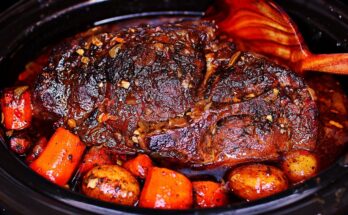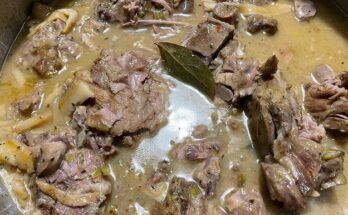Jacket Potato Recipe: A jacket potato, also known as a baked potato, is one of the simplest yet most satisfying meals you can whip up in your kitchen. At its core, it’s just a whole potato baked until the skin turns crispy and the inside becomes fluffy and soft. What makes it shine, however, is its versatility. You can serve it plain or dress it up with a mountain of toppings—from a slab of melting butter to a hearty ladle of chili.
This humble dish has roots in British cuisine but is loved all over the world for its comfort, ease, and taste. Whether it’s a cold winter evening or a quick midweek dinner, jacket potatoes hit the spot every time.
Why Are They So Popular?
Why are people so obsessed with jacket potatoes? It’s because they tick every box. They’re:
- Cheap – Potatoes are one of the most affordable staples.
- Easy – You don’t need culinary skills to make one.
- Healthy – With skin on, they’re full of fiber and nutrients.
- Customizable – Sweet or savory, the topping combos are endless.
Jacket potatoes are also an excellent choice for those following gluten-free or vegetarian diets. They work perfectly as a side dish or a main course depending on what you pile on top.
Choosing the Right Potato
Best Types of Potatoes for Jacket Potatoes
Not all potatoes are created equal, especially when it comes to jacket potatoes. The goal is to get a crispy skin with a fluffy interior, and for that, starchy potatoes are your best friend. Here are some top picks:
- Russet Potatoes (USA) – These are the gold standard for baking. Their thick skins crisp up beautifully, and their starchy insides become deliciously fluffy.
- King Edward or Maris Piper (UK) – Both varieties are fantastic for jacket potatoes due to their high starch content and flavorful flesh.
- Sweet Potatoes – While not traditional, they offer a sweet twist and are packed with nutrients.
Avoid waxy potatoes like red potatoes or new potatoes—they don’t fluff up the same way and might give you a dense center instead.
Prepping Your Potatoes for Perfection
Preparation is key to nailing the perfect jacket potato. Here’s what you need to do before they hit the oven:
- Clean Thoroughly – Scrub each potato under running water to remove any dirt. Since you’ll be eating the skin, cleanliness is essential.
- Dry Completely – After washing, pat the potatoes dry with a towel. Moisture will hinder the crisping of the skin.
- Prick with a Fork – Use a fork to pierce each potato several times. This allows steam to escape and prevents them from bursting in the oven.
- Optional Soak – Soaking potatoes in saltwater for 10 minutes can help draw out some starch and promote crispiness.
These simple steps can make the difference between a mediocre and a mouthwatering jacket potato.
Essential Ingredients and Tools
Simple Ingredients List
You don’t need a fancy pantry to make a killer jacket potato. Here’s your basic list:
- 4 large starchy potatoes (Russet or Maris Piper)
- 1–2 tbsp olive oil or vegetable oil
- Coarse sea salt
Optional Toppings:
- Butter
- Grated cheddar cheese
- Sour cream
- Chopped green onions
- Baked beans
- Bacon bits
- Chili con carne
Whether you want to keep it traditional or go gourmet, toppings can be tailored to any preference or dietary need.
Recommended Kitchen Tools
While the recipe is pretty low-maintenance, having the right tools can enhance your experience:
- Oven – A conventional oven works best for even baking.
- Baking tray or wire rack – For circulation and to prevent sogginess.
- Aluminum foil (optional) – Some like to wrap potatoes, though this softens the skin.
- Fork – For pricking and testing doneness.
- Tongs or oven mitts – To handle hot potatoes safely.
These tools are usually already in most kitchens, making jacket potatoes an easy go-to recipe any time.
Step-by-Step Jacket Potato Recipe
Step 1: Washing and Pricking the Potatoes
Start by scrubbing your potatoes under cool running water to remove all the dirt and debris. Since the skin is a major feature of a good jacket potato, you want it clean and ready to crisp. After washing, pat each potato dry thoroughly with a paper towel or clean dish cloth.
Next, grab a fork and pierce each potato about 6-8 times all over. This is crucial—if you skip this step, steam can build up inside and cause your potato to explode in the oven. Nobody wants to clean potato bits off the oven walls!
You can also lightly massage the potato with your hands at this point to feel for any soft spots or blemishes. If you find any, simply cut them out with a knife. Make sure your potatoes are all roughly the same size for even cooking.
Step 2: Coating with Oil and Salt
Once your potatoes are clean and pricked, it’s time to enhance their flavor and texture. Begin by drizzling each potato with a small amount of olive oil, ensuring the entire surface is lightly coated. This oil not only adds flavor but also contributes to the crispiness of the skin. After oiling, sprinkle a generous pinch of coarse sea salt over each potato. The salt not only seasons the skin but also aids in drawing out moisture, leading to a crisper finish.
For an extra layer of flavor, consider adding freshly ground black pepper or your favorite herbs and spices. Some people enjoy a touch of garlic powder or smoked paprika to give the potatoes a unique twist. Once seasoned, place the potatoes on a baking tray lined with parchment paper or a wire rack to allow even air circulation during baking.
Step 3: Baking the Potatoes to Crispy Perfection
Preheat your oven to 400°F (200°C). Once the oven reaches the desired temperature, place the prepared potatoes directly on the middle rack or on a baking tray. Baking directly on the rack allows heat to circulate around the entire potato, promoting even cooking and a uniformly crispy skin.
Bake the potatoes for approximately 1 hour to 1 hour and 30 minutes, depending on their size. To test for doneness, insert a fork or skewer into the center of a potato; it should slide in easily without resistance. The skin should be golden brown and crisp to the touch.
For an even crispier skin, some enthusiasts recommend baking the potatoes for an additional 10-15 minutes after the initial cooking time. This extra step ensures a thick, crunchy exterior while maintaining a fluffy interior.
Once baked to perfection, remove the potatoes from the oven and let them rest for a few minutes. This brief resting period allows the steam inside to redistribute, making the potatoes easier to handle and enhancing their texture.
Delicious Topping Ideas
Classic Butter and Cheese
The simplicity of butter and cheese remains a timeless favorite for jacket potato toppings. Start by slicing the baked potato open lengthwise and gently fluffing the interior with a fork. Add a generous pat of butter, allowing it to melt into the fluffy potato flesh. Follow this with a handful of grated cheddar cheese, which will melt from the residual heat, creating a gooey, savory delight.
For added flavor, sprinkle chopped chives or green onions on top. A dollop of sour cream can also complement the richness of the butter and cheese, adding a tangy contrast. This combination offers a comforting and satisfying meal that’s quick to prepare and universally loved.
Healthy and Creative Alternatives
For those seeking healthier or more adventurous toppings, the possibilities are endless:
- Greek Yogurt and Herbs: Substitute sour cream with Greek yogurt for a protein-rich, lower-fat option. Add fresh herbs like dill or parsley for a refreshing taste.
- Tuna and Sweetcorn: Mix canned tuna with a small amount of mayonnaise and sweetcorn kernels. Spoon this mixture into the baked potato for a light yet filling meal.
- Chili Con Carne: Top the potato with a hearty spoonful of chili con carne, adding a spicy kick and turning the dish into a robust main course.
- Vegetarian Bean Mix: Combine black beans, diced tomatoes, corn, and avocado for a colorful, nutritious topping that caters to vegetarian diets.
- Spiced Lentils: Cook lentils with cumin, coriander, and turmeric, then spoon over the potato for a flavorful, plant-based option.
Experimenting with different toppings allows you to tailor the jacket potato to your taste preferences and dietary needs, making it a versatile dish suitable for any occasion.
Creative Ways to Serve Jacket Potatoes
Serving as a Main Dish
One of the best things about jacket potatoes is their ability to transform into a hearty, stand-alone main course. By simply choosing protein-rich toppings and loading up on veggies, you’ve got a complete meal in a single potato. For instance:
- Chili-Topped Jacket Potatoes: Serve with a scoop of spicy chili, a sprinkle of shredded cheese, and a spoonful of sour cream.
- Pulled Pork and Slaw: Add leftover pulled pork, barbecue sauce, and a crunchy slaw for a smoky, sweet, and tangy meal.
- Creamy Chicken and Broccoli: Dice cooked chicken, steam some broccoli, and mix both in a light cream sauce to spoon over the potato.
These toppings not only taste amazing but also turn the humble spud into a fulfilling dish that can easily replace your regular dinner.
Turning it Into a Side Dish
Not every meal needs to be centered around a potato—sometimes, it’s the perfect companion. Jacket potatoes can be served alongside grilled meats, hearty soups, or big, leafy salads. Here’s how you can style them as sides:
- Mini Jacket Potatoes: Use baby potatoes instead of full-sized ones. They’re perfect for portion control or party platters.
- Herb Butter Topping: Skip the cheese and sour cream. Just slice and smear on some homemade herb butter (parsley, thyme, garlic) for a light and fragrant side.
- Pairing Ideas: Serve next to a steak, roast chicken, or even fish for a well-rounded plate.
As a side, jacket potatoes add that comforting, starchy component that rounds out your meal, without overshadowing the main star.
Storage and Reheating Tips
How to Store Leftover Jacket Potatoes
It’s rare to have leftovers with jacket potatoes, but if you do, they store surprisingly well. Follow these steps to keep them fresh:
- Let Them Cool: Allow the potatoes to cool completely before storing.
- Wrap Individually: Wrap each potato in foil or plastic wrap to keep them from drying out.
- Use an Airtight Container: If you’ve added toppings already, place them in a container to maintain freshness.
Stored properly in the fridge, jacket potatoes will stay good for up to 3 days.
Best Reheating Methods
When it comes to reheating, avoid the microwave if you want to keep that lovely crispy skin. Here are better alternatives:
- Oven Method: Preheat to 350°F (175°C), and reheat the potato on a baking tray for 15–20 minutes.
- Air Fryer: Reheat at 375°F for about 10 minutes. This is perfect for restoring crispiness quickly.
- Microwave (in a pinch): If you must use a microwave, place a damp paper towel over the potato to prevent it from drying out, and heat for 2–3 minutes.
No matter which method you choose, make sure the inside is steaming hot before serving again.
Nutritional Value of Jacket Potatoes
Health Benefits
Despite their carb-heavy reputation, potatoes pack a solid nutritional punch, especially when served with the skin on. Here’s why they’re good for you:
- Rich in Fiber: The skin is loaded with dietary fiber, which promotes digestive health.
- High in Vitamins: Potatoes are a great source of vitamin C and B6.
- Potassium Powerhouse: They contain more potassium than a banana!
- Low in Fat: When not loaded with heavy toppings, they’re naturally fat-free.
When paired with healthy toppings like veggies or lean proteins, jacket potatoes can be a wholesome addition to any diet.
Calorie Breakdown with Common Toppings
Here’s a simple table to help understand the calorie count of various jacket potato combinations:
| Topping Combo | Calories (approx.) |
|---|---|
| Butter only | 250–300 |
| Cheese & Sour Cream | 400–450 |
| Tuna & Sweetcorn | 350–400 |
| Chili Con Carne | 500–550 |
| Plain with Skin Only | 150–180 |
Moderation and smart topping choices are key if you’re watching your calorie intake.
Common Mistakes to Avoid When Making Jacket Potatoes
Skipping the Prick
One of the most common rookie mistakes when baking jacket potatoes is forgetting to prick them. This might seem like a minor detail, but it’s crucial. Potatoes build up steam inside as they bake. Without those tiny escape holes made by a fork, the steam has nowhere to go—and that’s how you end up with an exploded potato and a messy oven. Always prick each potato several times before baking.
Wrapping in Foil (If You Want Crispy Skin)
Some folks automatically wrap their potatoes in foil before baking. While this is okay if you want a softer skin, it’s a big no-no if crispy skin is what you’re after. Wrapping in foil traps moisture, essentially steaming the potato. For the best results, bake your spuds unwrapped and directly on the oven rack or a baking tray.
Under or Overbaking
Undercooked potatoes are hard in the middle and just not pleasant to eat. Overbaked ones can dry out or burn. The key is to know your potato size and keep an eye on the clock. A good rule of thumb is 60 to 90 minutes at 400°F (200°C). Check for doneness by sticking a fork in—the flesh should be soft, and the skin should be crisp.
Forgetting the Resting Time
Once you pull the potatoes out of the oven, let them rest for about 5–10 minutes. This allows the interior to settle, making them easier to cut open and fluff up. Resting also helps maintain moisture inside without losing the crispy outer layer.
FAQs about Jacket Potato Recipe
1. Can I make jacket potatoes in the microwave?
Yes, you can! Microwaving speeds up the process. Microwave for about 5–6 minutes per potato, flipping halfway. For crispy skin, finish in the oven for 10–15 minutes.
2. How do I make jacket potatoes vegan?
Swap out dairy-based toppings for plant-based alternatives like vegan cheese, hummus, or spiced lentils. The potato itself is naturally vegan.
3. What’s the best way to make the skin crispy?
Oil and salt the skin, then bake uncovered on a rack at high heat. Avoid wrapping in foil and don’t overcrowd the oven.
4. How long can I store baked potatoes?
Stored in the fridge, baked jacket potatoes last up to 3 days. Reheat in the oven or air fryer for best results.
5. Can I freeze jacket potatoes?
Absolutely. Let them cool completely, wrap tightly in foil or plastic, and freeze. They’ll keep for about a month. Reheat in the oven straight from frozen.
Conclusion
There you have it—the ultimate step-by-step guide to creating the perfect jacket potato. Whether you’re craving something cheesy and indulgent or looking for a lighter, veggie-packed meal, jacket potatoes are the ideal blank canvas. They’re easy, affordable, and endlessly customizable. By following these steps—choosing the right potato, prepping properly, and baking with care—you’ll master this humble dish and turn it into a meal you’ll want to make over and over again.
From busy weeknights to cozy weekends, jacket potatoes can be your go-to comfort food. Get creative with toppings, explore new flavors, and don’t be afraid to experiment. The perfect potato is just an oven away.



